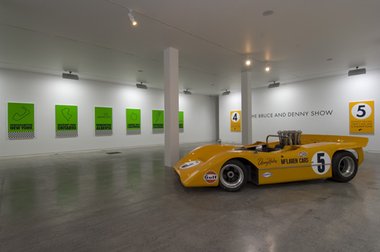Andrew Paul Wood – 6 August, 2016
Sport and art often seem like mutually exclusive, even hostile camps, but this is only a recent phenomenon, despite the tendency of the powers that be to lump them in together with entertainment when it comes to the paperwork. They have quite a lot in common - neither serve a particularly pragmatic purpose, both exist primarily for the satisfaction of the individual performer and their audience.
The Olympic Games are upon us.
Sport and art often seem like mutually exclusive, even hostile camps, but this is only a recent phenomenon, despite the tendency of the powers that be to lump them in together with entertainment when it comes to the paperwork. Indeed there is almost a kind of prejudice that perhaps originates with a misapplication of Kant’s distinction between the phenomenal and the noumenal, the art world assigning sport to the former. Professional sport and the arts have quite a lot in common - neither serve a particularly pragmatic purpose, both exist primarily for the satisfaction of the individual performer and their audience. At the same time both art and sport have their own distinct hermeneutics. If Arthur Danto can have an Art World, one can probably argue for a Sport World as well.
Classical art is full of celebrations of the ideal athletic body and sporting prowess. Admittedly this is mostly male, though occasionally the odd Artemis or Atalanta slip in. Most of that came to an end in the first half of the twentieth century when it became a favourite trope of the two leading totalitarian ideologies of the day, Fascism and Communism, though it lingers with us in the marketing of sport and the occasional brain fart.
Monuments abound (Timaru alone boasts statues of Phar Lap, boxer Bob Fitzsimmons, and runner Jack Lovelock) and it would be easy enough just to zero in on sport photography, but again we run into similar problems. There are the cliché action shots that all tend to look the same after a while and which the media are especially keen on, and then there is that whole Leni Riefenstahl aesthetic which is altogether too seductive.
It is, however, perfectly possible to make art in celebration of sport without all those quasi-fascist trappings. Ex-Hamilton, Melbourne-based artist Richard Lewer just won the Basil Sellers Art Prize for his work The Theatre of Sports. His beautifully expressive, knowingly naïve painting style takes familiar dramatic photojournalism of athletes at the point of greatest strain or exhaustion, and transforms them from demigods to something altogether more human and vulnerable - as we might imagine them to be on the inside at that moment.
Sport also features in an earlier Lewer work from 2001, the performance piece Boxing Match Richard Lewer vs Mark Sinclair. The performative/spectacle aspect of sport and its physicality lend themselves very well to video, performance and body art. Alex Monteith’s video works incorporating her love of surfing are no doubt familiar and certainly worthy, though sometimes feel a bit too ‘does-what-it-says-on-the-tin’ to me. Ryan Ballinger in New Plymouth, out of similar territory, makes exciting performance/body-based work drawing on the endurance and physicality of the marathon.
The indefatigable Philip Trusttum between 1991 and 1995 produced a series of paintings inspired by his love of playing tennis, and a rugby series. Rugby is still very much a part of the national culture, and there is a tendency to trot out the younger and better-looking All Blacks to sell clothes in their smalls, but artistically that would almost certainly be the laziest thing you could do.
In 2013 I was involved in a project with Christchurch artist Rudolf Boelee called Waddarya? in which the artist applied the Warholian aesthetics and techniques of Pop Art to the battered, anti-prettyboy mugs of the All Black greats of old when the game was brutal, gladiatorial, and the epicentre of New Zealand identity. This chimes rather nicely with Mark Braunias’s Black Order from his Emblems of Identity series (1988-1993), which takes the opposite path, rendering All Blacks generic and anonymous by erasing their faces. Another inversion is Kirsty Gregg‘s 15 Rugby Balls back in 2001, signed by her dream team of New Zealand artists as a kind of parody of the country’s sporting obsession.
Perhaps the most direct (and fun) appropriation of sport by a New Zealand artist so far is David Cross’ Level Playing Field, a giant inflatable bouncy castle-type sculpture which graced Christchurch’s Cathedral Square in 2013 as part of SCAPE 7, complete with Top Town event-type games. Equally outrageous fun are Glenn Burrell’s crafting of skins of house paint into items of sporting apparel in Ski Expedition (2011), Flipper Expedition (2012), and Bike Expedition (2012), often leaving a trail of pigment behind them.
There’s plenty of room for crossover and very little point in purism,. The jocks shouldn’t mock the art geeks because lots of artists are in that milieu. Sport, in all its manifestations, shouldn’t be something for the art world to fear or mock. A great many people straddle both quite comfortably. In fact, in the right hands, they can work very well together.
Andrew Paul Wood

 Two Rooms presents a program of residencies and projects
Two Rooms presents a program of residencies and projects Advertising in this column
Advertising in this column



This Discussion has 0 comments.
Comment
Participate
Register to Participate.
Sign in
Sign in to an existing account.